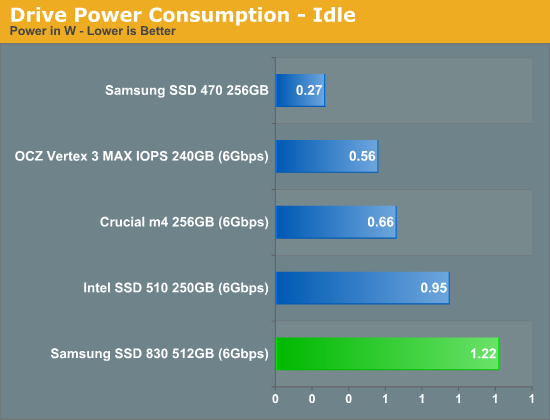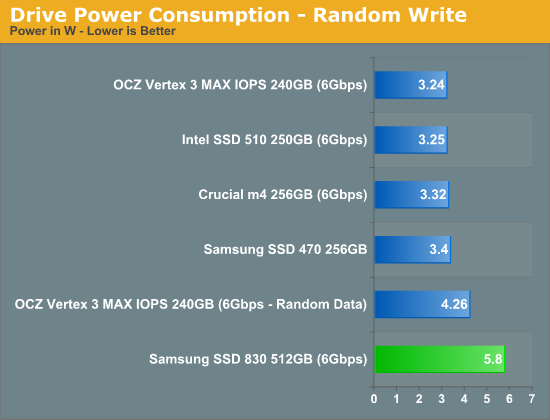The Samsung SSD 830 Review
by Anand Lal Shimpi on September 24, 2011 1:02 AM EST- Posted in
- SSDs
- Storage
- Samsung
- pm830
- Samsung SSD 830
Power Consumption
Samsung sampled the 512GB version of the SSD 830 so it's unclear how much the sheer number of NAND die impacts power consumption here. At 1.22W while idle the 830 seems to draw 28% more power than the Intel SSD 510. Under load that gap drops to only 14% during sequential writes but skyrockets to 70% under random writes. Again part of this is likely due to the higher capacity. Until we get lower capacity drives it's impossible to tell how much the power consumption story will change.













99 Comments
View All Comments
spudit88 - Saturday, September 24, 2011 - link
Great review- I've installed several of the 470 Series and they have been very reliable. I don't believe we have had issues with any of them. These are mostly going into corporate laptops, so the fastest SSD's are not always the best option. I've stuck mainly with Samsung or Intel for reliability reasons. We are just now starting to deploy more laptops with 6Gb/s interfaces, it's good to know there are more choices out there....particularly with a larger drive option of 512GB.know of fence - Saturday, September 24, 2011 - link
The Sizes of these drives are multiples of 2, (64,128), does this imply that GB means the same as GB inside Windows, Gibibyte a.k.a 2^30 Byte or 1.073*10^9 Byte. Same as with RAM.Or does "GB" refering to SSD Sizes actually mean something completely different than MB (per second) in Speed Benchmarks.
know of fence - Saturday, September 24, 2011 - link
Sorry, It's all explained. Still a bummer, though.buzznut - Saturday, September 24, 2011 - link
Two years ago, Samsung seemed convinced the way of the future was hybrid drives that combined the best of both worlds-the capacity of a mechanical with the performance of an SSD. They had a lot of reliability problems with these drives, I expect that's why there aren't more of these drives on the market.What I am wondering is has Samsung completely abandoned this idea? What about other manufacturers? Do you think that the cost of producing such drives makes it impractical?
Some of the average performing SSDs have come down to the $1/GB price point, which is seemingly the magic number for those folks still hanging on desperately to their mechanical drives. Now I hear these same folks complaining about reliability being the main issue keeping them from adopting new technology, and they aren't wrong.
I haven't had any issues with my SSDs, I find them to be extremely reliable and now I don't think I could go back for a system drive. Initially I had an X25 40GB, now a 128GB Vertex III. So the reliability of the Samsung drives is refreshing news and I sincerely hope the drives will be priced competitively because I'd really like to see them succeed with this.
I still think, if implemented properly, that there is a market for hybrid drives. Don't know that anyone is willing to risk that though.
Evonick - Saturday, September 24, 2011 - link
I'm curious if anyone knows the actual time involved for idle time garbage collection, and whether that process is equivalent to TRIM? Anand mentions "overnight" in the review, but does itgc really take 8 hours? And when does it start? After 3 minutes of idle or 3 hours? And when the itgc is completed, how does the drive perform compared to a TRIMmed drive?FunBunny2 - Saturday, September 24, 2011 - link
-- I've been working on an enterprise workload suite to figure that out...In order for this to be "real", encrypted data input is required. The reason is that relational databases in Enterprise are increasingly configured with encryption.
tpi2007 - Saturday, September 24, 2011 - link
I Anand, congratulations for the review and the video review, both of which I enjoyed very much.I was looking at the power consumption figures and was wondering if Samsung's higher numbers could have to do with their use of DDR2 for cache ? And by that I mean two things:
1. The fact that it's much bigger than Intel's for example should add to the power consumption, adding to the fact that they store user data, which probably means more data being written and read from all the time, increasing power consumption;
2. The fact that it's DDR2. Is it low power DDR2 or just normal 1.8v DDR2 ? That could explain the higher power consumption to a certain extent too. What if Samsung were to use low power 1.35 or even better, 1.25v DDR3L ?
Best regards,
tpi2007
FunBunny2 - Saturday, September 24, 2011 - link
Along similar lines: why is there not a power loss test in the suite? There appears to be no superCap on the board, yet the part uses "massive" amounts of DRAM with user data. This looks like a bleeding Achille's heel.enigma80 - Saturday, September 24, 2011 - link
This worried me too. 256MB of user data in a limbo?It would be importante to test a power loss amid writing to the drive and check the data on the drive.
Obsoleet - Thursday, January 19, 2012 - link
Excellent points. I'd like to hear an answer to this.The more I read, the more I feel Intel is the way to go.. even vs this Samsung and M4s.